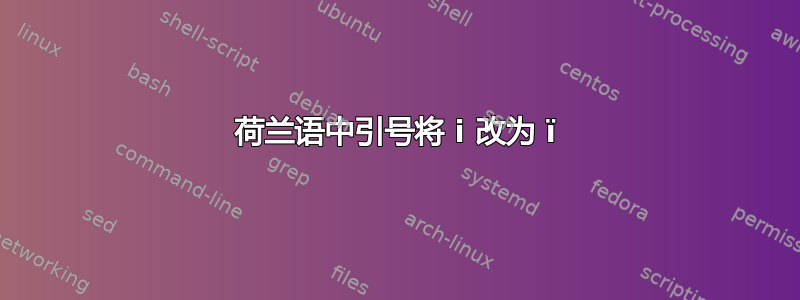
\documentclass[a4paper,11pt]{report}
\usepackage[dutch]{babel}
\usepackage[utf8]{inputenc}
\begin{document}
het "interessante" voorbeeld
\end{document}
这导致了“有趣的”结果。
我可以通过添加空格 \ 来部分解决此问题,但随后我得到了一个真正多余的不需要的空格“ interessante”voorbeeld。请注意,第二个“ ”后的空格也消失了...
如何解决?
答案1
每本 LaTeX 手册都会告诉你,输入引号的正确方法是不是使用"。
你应该做
het ``interessante'' voorbeeld
或者
het “interessante” voorbeeld
使用babel-dutch,组合"<vowel> 会打印具有上述分音符号的元音:
"a "e" "i "o "u
将打印
藝術本身
后面"跟一个空格则忽略它(出于技术原因)。直双引号字符"还有其他用途,请参阅babel手册。
例如,请注意我正在fontenc使用 T1 选项加载,这是推荐用于荷兰语的。
\documentclass[a4paper,11pt]{report}
\usepackage[T1]{fontenc}
%\usepackage[utf8]{inputenc} % no longer needed
\usepackage[dutch]{babel}
\begin{document}
het "interessante" voorbeeld (wrong)
het ``interessante'' voorbeld (right)
het “interessante” voorbeld (right)
"a "e "i "o "u
\end{document}
答案2
这些似乎是由包加载的特定于语言的设置babel。请注意,即使停止此特定行为,它也会产生不正确的引号对,如下所示:
这肯定不是你想要的。
正确的方法是在左侧使用反引号符号(` 表示单引号,`` 表示双引号),在右侧使用单引号 '。
\documentclass[a4paper,11pt]{report}
\usepackage[dutch]{babel}
\begin{document}
het ``interessante'' voorbeeld
\end{document}
更安全的方法是使用 quotation 包csquotes。它负责处理特定于语言的排版:
\documentclass[a4paper,11pt]{report}
\usepackage[dutch]{babel}
\usepackage{csquotes}
\begin{document}
het \enquote{interessante} voorbeeld
\end{document}
答案3
我使用了上述答案的组合:\newcommand{\dq}[1]{"#1"} 这似乎解决了这个问题,而且说实话它非常方便......我已经使用了 \renewcommand{\emph}[1]{\textbf{"#1"}} 并且这也解决了这个问题......感谢您的建议!






